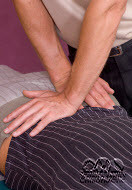
Cervical radiculopathies, also known as a "pinched nerves" or a "pinched vertebral artery," happens when a nerve inside the cervical region is irritated or compressed where it branches off from the spinal column. This can cause severe pain radiating down the arm and/or shoulder, along with muscle weakness and numbness, and/or tingling.
This type of nerve can be irritated or compressed by compression or trauma
These types of injuries usually occur during some type of sports activity. Some common sports injuries include tennis elbow, rotator cuff tears, head and neck fractures, whiplash, spinal stenosis, or even fractures of the cervical spine.
When these injuries occur, chiropractic care or medical intervention to relieve the pain is usually recommended. Depending on the seriousness of the injury, specific treatment may need to be applied, depending on the severity of the injury.
In most cases, chiropractic care or medical intervention is recommended using spinal manipulation. Chiropractors can do this through manual therapy, traction, laser therapy, electrical stimulation, and spinal manipulation. Manual therapy, traction, laser therapy, and electrical stimulation are used primarily for pain management and are usually performed through the use of a hand-held device that can be maneuvered around the patient's body. While some patients will require more than one of these treatments to completely relieve the symptoms of a pinched nerve, chiropractic care can help reduce symptoms and promote recovery.
Manual therapy for a pinched nerve is typically combined with spinal manipulation. Using the right type of manual therapy can result in better results than with spinal manipulation alone. Manual therapy is usually best combined with traction and laser therapy because they target specific pressure points within the back, neck, shoulders, and arms.
Sometimes spinal manipulation alone will not be enough to help relieve the symptoms of a pinched nerve. The proper diagnosis, whether it is an acute or chronic condition, should be performed by a chiropractor. In most cases, this will involve diagnostic testing to determine the exact nature of the problem and the appropriate course of action.

With the appropriate diagnosis, the chiropractor can then provide the necessary medical intervention
He may recommend anti-inflammatory medications to reduce swelling and inflammation, such as Ibuprofen and other nonsteroidal anti-inflammatory drugs. to reduce the pain, and the onset of fever.
Once the medical intervention is complete, chiropractic care or medical intervention can then be continued to relieve the symptoms and prevent recurrence of the problem. For example, chiropractic treatment can relieve muscle spasms caused by stress.
Chiropractors can also use spinal manipulation to help treat patients who suffer from chronic conditions. Chronic conditions include pinched nerves, disc degeneration, nerve root blockages, pinched nerves, and musculoskeletal disorders such as arthritis and osteoporosis.
Chiropractic care is not suitable for every patient. In fact, some patients may experience too much pressure on their spine while undergoing treatment.
Chiropractic care should only be used as a last resort when all other methods of pain relief have failed. If chiropractic care is prescribed for a patient, it is important that he or she consult with his or her doctor before beginning any type of chiropractic care.
In addition, chiropractic care should only be used for minor problems. Chiropractic care is not suitable for treating patients who have a severe medical condition or an underlying medical condition, such as an infection.
Even if chiropractic care is performed, patients should also seek medical assistance. Any form of manipulation should be performed under the supervision of a doctor, to prevent the possibility of further injury to the spine or nervous system. It is best to avoid any further injury to the spine and nervous system by avoiding direct exposure to any type of manipulation. To prevent further injuries to the spinal cord and nervous system, patients should avoid strenuous activity and perform daily activities only on days that they are not feeling their best.